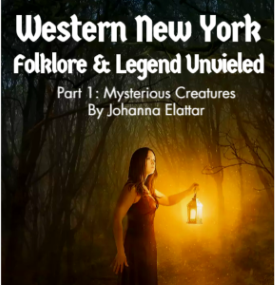Part 1: Mysterious Creatures of Western New York
Have you heard of local legends like the “Black Creek Whodat?”
By: Johanna Elattar
Western New York, known to many as “The Western Door,” is steeped in rich cultural history and folklore, particularly within the Seneca territory and its surroundings. These lands are not only famous for their natural beauty but also for the eerie legends that have been passed down through generations. From monstrous beasts to spectral apparitions, the region’s folklore offers a tapestry of stories that blend Native American legends with tales from more recent history. Here, we explore some of the most intriguing and spine-chilling stories from Western New York.
High Hat of Salamanca
In the marshy expanses of the Allegany Seneca Reservation lurks a fearsome figure known as High Hat. According to local legend, High Hat is a giant, cannibalistic creature with a mouth full of sharp teeth, notorious for preying on children. The name “High Hat” comes from his supposed attire – a stovepipe hat reminiscent of President Abraham Lincoln, adding a peculiar twist to his terrifying persona.
The creation of the Kinzua Reservoir between 1960 and 1965 brought many non-Natives into the region, some of whom claimed to have seen a strange, large figure along the northern shore at dawn. These sightings, coupled with the chilling stories told by Seneca storytellers like DuWayne “Duce” Bowen, have cemented High Hat’s place in local folklore. Workers on the dam project would often ask each other, “Anybody see old Abe Lincoln today?” highlighting how common these sightings became.
The Hellhounds of Goodleberg Cemetery, Wales
Goodleberg Cemetery in Wales has long been a site of paranormal intrigue. Once a local haunt, it gained national attention after being featured in the 1997 book Shadows of the Western Door. The cemetery’s eerie reputation drew ghost hunters and thrill-seekers, many of whom reported encounters with ghostly apparitions. The most distinctive of these are the spectral black dogs with glowing eyes, reminiscent of the Hellhounds of European folklore.
In Old World folklore, black dogs are often seen as protectors of the dead or manifestations of demonic entities. Their presence in Goodleberg Cemetery is a rare occurrence in American ghost lore, adding a unique twist to the area’s haunted history. While some ghost hunters’ activities have led to vandalism and frustration for local residents, the stories of these Hellhounds continue to captivate and terrify those who hear them.
The White Bigfoot of Belmont and The Black Creek Whodat
Central Allegany County has been the epicenter of mysterious creature sightings, particularly the enigmatic White Bigfoot of Belmont and the Black Creek Whodat. The Black Creek Whodat, first reported in the 1970s, is described as a light-colored, Bigfoot-like creature. Its bizarre appearance and behavior have left locals puzzled and wary.
In 1999, two high school girls reported seeing a large, beige creature near West Almond, about eight miles east of Belmont. This sighting added to the legend of the White Bigfoot, further fueling speculation about these cryptids. Both creatures are notable for their light coloration, a feature uncommon among Bigfoot sightings, making these legends all the more intriguing.
The Manitou Road Demon, Greece
Manitou Road in Greece, named after the Algonquin word for a life force or spiritual energy, has been the scene of numerous supernatural encounters. One of the most famous is the Manitou Road Demon, a fast, fanged creature that has terrorized residents for generations. Late Monroe County historian Shirley Cox Husted recounted her own encounter with the beast in the 1940s, describing it as something far more menacing than a bird.
Reports of this demon have persisted over the years, with many locals claiming to have seen or heard it harassing cars and tapping on windows. The road’s name itself suggests a place imbued with a powerful, free-ranging energy, perhaps explaining the demon’s persistent presence.
The Pigman of Angola
Holland Road in Angola is home to one of Western New York’s most grotesque legends – the Pigman. This monstrous figure, reportedly a man with severe facial deformities, has become a staple of local folklore. The legend began circulating in the 1990s, and despite its relatively recent origin, it has quickly become a major figure in the region’s paranormal landscape.
M.C. Hageman’s research connected the Pigman to a resident named William Derrecks, whose severe deformities and tragic death in a house fire on Halloween night in 1973 may have given rise to the legend. Whether viewed as a ghostly presence or a manifestation of the area’s tragic history, the Pigman continues to haunt the imaginations of those who traverse Holland Road.
The Hobgoblin of Fort Niagara, Youngstown
Fort Niagara, with its rich history and numerous ghost stories, is also home to the Hobgoblin of the black hole, a cavelike cell used for solitary confinement. The first report of this creature came from a musician named John Carroll in 1804, who, after being confined to the black hole, claimed to have been inspired by a hobgoblin to write a song.
Hobgoblins, small and mischievous creatures from British folklore, are rare in American ghost stories, making this legend particularly unique. The Fort’s graveyard is also said to be haunted by a similar creature, suggesting that the Hobgoblin might have a companion in its spectral mischief.
The Great Snake of the Allegany
Serpents and dragons have long been a part of Native American legends, and the Great Snake of the Allegany is no exception. During the construction of the Kinzua Dam, numerous sightings of a giant serpent were reported in the Allegany hills. Some Native legends suggest that there are four such serpents, representing the four cardinal colors of the Iroquois system: black, red, white, and yellow.
Witnesses reported seeing a massive serpent making ripples in the Kinzua Reservoir, comparable in size to the world’s largest constrictors. These sightings add a layer of mythic grandeur to the region’s folklore, suggesting that the Great Snake is a guardian or a symbol of the area’s deep-rooted spiritual history.
The 1920 Incident, North Tonawanda
In the summer of 1920, North Tonawanda experienced a week-long hysteria over sightings of a giant human-form apparition. This floating, kite-like figure was seen by numerous credible witnesses, including a policeman, and even disrupted traffic at times. A local bicycle club attempted to capture the apparition but failed.
The varying descriptions of this entity, which included elements reminiscent of Native American headdresses or masks, bear a striking resemblance to the Mothman sightings of West Virginia. This incident remains one of the most mysterious and well-documented paranormal events in the region.
The Oak Street Specter, Batavia
In June 1905, Batavia’s Oak Street was the scene of bizarre encounters with a shape-shifting specter. This creature, described as morphing between forms such as a bull, a cat, and a headless woman, terrorized locals and defied explanation. Such shape-shifting abilities are reminiscent of Old World folklore figures like the Gaelic pooka.
These encounters suggest a survival of Old World supernaturalism in New York, blending with local legends to create a uniquely eerie narrative. The Oak Street Specter’s ability to change form makes it one of the most unsettling apparitions in Western New York’s haunted history.

The Anti-Hubbard, East Aurora
East Aurora’s supernatural scene includes a terrifying figure known as the Anti-Hubbard. Resembling the founder of Roycroft in attire but with a skinless, demonic face, this entity has been reported at multiple sites, including the Roycroft Campus. Its frightening appearance sets it apart from more typical ghost sightings, which often resemble natural images caught in a time-loop.
This unique and terrifying apparition adds a dark twist to East Aurora’s rich historical and paranormal tapestry, blending the familiar with the grotesque.
The Leaping Loopy of Leicester
In October 1870, Leicester experienced a wave of sightings of an unusual bipedal creature. This beast, described as a mix of animal parts and behaviors, hopped like a kangaroo and fought like a bear. Known as an Altered-Animal Form (AAF), this creature reflects the region’s history of Seneca settlement and the belief in animal spirits or transformations.
These sightings suggest a blend of cultural beliefs and local folklore, creating a creature that defies simple categorization and adds to the region’s rich paranormal history.
The Lockport Imp
In December 1867, the house of tailor William Schaak in Lockport was troubled by a grim little supernatural creature. This incident, lasting barely a day, captured the attention of local newspapers. Descriptions of the imp resemble medieval familiars, creatures believed to serve witches.
While such an episode is unique in Western New York, it hints at the possibility of poltergeist activity, adding a touch of historical mystery to Lockport’s folklore.
The Shapeshifters
Among the Seneca and other Iroquois peoples, the ability to change shape is a hallmark of witchcraft. Modern-day reservation folk still speak of “shapeshifters” or “changelings,” creatures that can partially transform into animals while retaining some human traits. These entities, often spotted behaving unusually, are believed to be witches or cursed beings.
These stories reflect deep-rooted cultural beliefs and add a mystical layer to the understanding of nature and the supernatural in Seneca tradition. Western New York’s folklore is a rich blend of Native American legends and tales from more recent history. These stories, whether of monstrous creatures or spectral apparitions, reflect the region’s deep cultural heritage and the enduring human fascination with the unknown. From the terrifying High Hat of Salamanca to the shape-shifting specter of Oak Street, these legends continue to captivate and chill those who hear them, ensuring that the mysteries of Western New York live on in the collective imagination.

Johanna is a Hornell NY based writer who enjoys the mystery and mystique of local legends! She also does great community news work and small business features. Contact her anytime, hauntedhill@yandex.com








